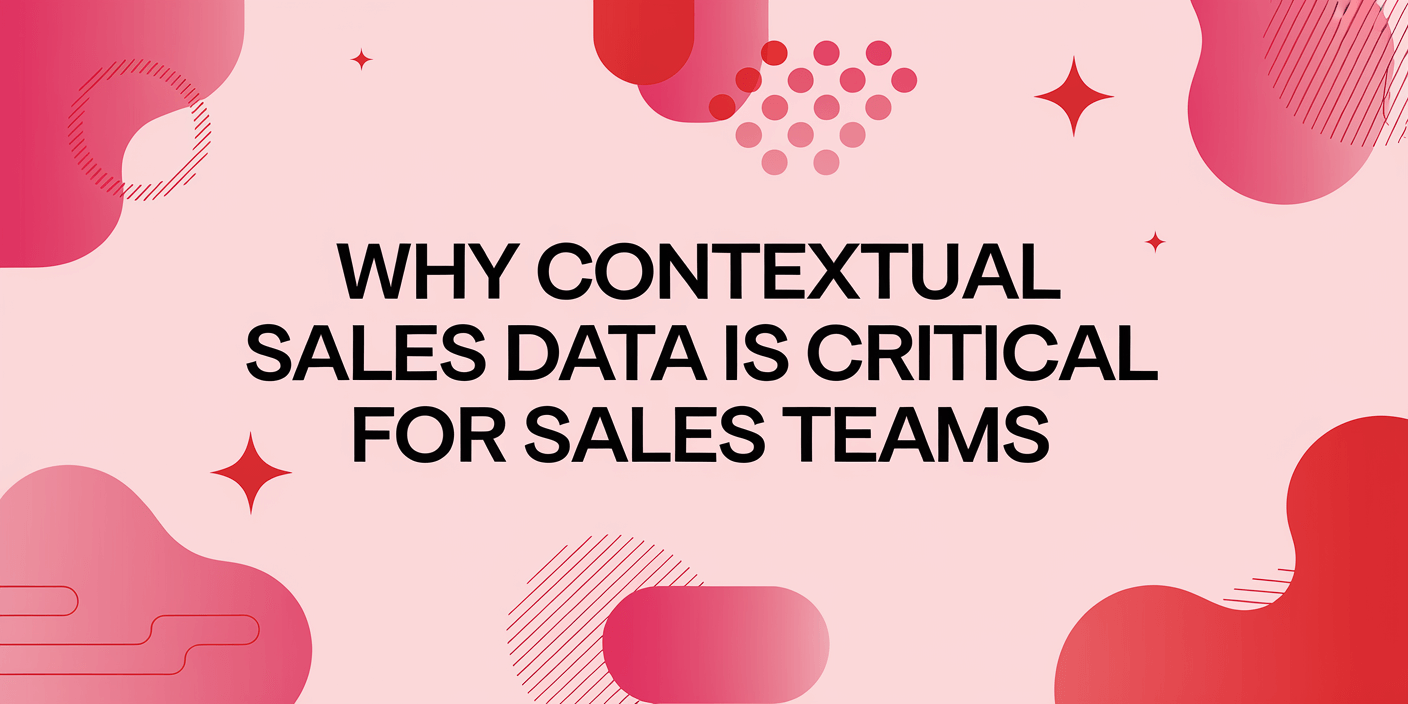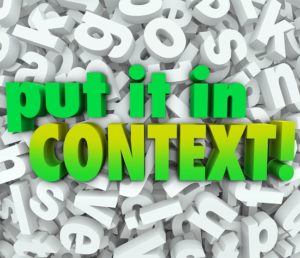
Why Contextual Sales Data Is the Secret to More Closed Deals
For sales teams, the data value chain has never been more promising than it is right now. As your prospects go about their day, interacting with websites, smartphones and the social web, the behavioral data profile about them continues to grow. It’s possible to know more than ever about their product preferences, usage, interactions, peer group, opinions, budget and pain points than ever. Personas are still helpful to the extent that sales managers are able to create playbooks for specific types and buying stages. However, contextual sales data about prospects gives us the opportunity to go far beyond personas and truly personalize each interaction.
 The question is, how do sales teams do this without sacrificing productivity? And for that matter, can tailored pieces of data be delivered in context so that workers make smarter decisions during the course of their workflow?
The question is, how do sales teams do this without sacrificing productivity? And for that matter, can tailored pieces of data be delivered in context so that workers make smarter decisions during the course of their workflow?
The means with which to do this has been evolving right under our noses. With the right tools and strategy, sales and marketing teams can work together to build a data value chain that can deliver the data you need when you need it most.
What is Contextual Sales Data?
Traditionally, business data has been something that is analyzed periodically – weekly, quarterly or monthly, to help companies make important decisions. Frankly, some data is still more useful this way. For example, Wall Street and the film industry are just two examples where referencing long-term data spanning years or decades is used as a reference point for today’s investments. Knowledge is gained by looking at long-term trends in response to specific market forces and buyers.
Contextual data is that which is delivered to the right person, at the right time, within an actionable context. For example, the date of your cousin’s birthday is posted on her Facebook page all year long, but that doesn’t mean you’ll remember or even see it. Think how much more useful that data becomes when Facebook automatically alerts you to the fact that it’s her birthday.
Why Contextual Data is Necessary for Inside Sales
This is even truer for inside sales agents, who now spend, by some estimates, up to 24% of their time researching to make outbound phone calls. That may seem like a lot of time, but consider the laboriousness of the process. First, assuming that a sales rep isn’t simply working down a call sheet, the sales rep has to decide who to contact. That requires a priority analysis of leads, contacts and opportunities that may or may not be assisted by a lead scoring solution. The sales agent may dig into CRM to see past communications history, including communications – calls, emails or meeting logs – with other agents. Often, that history is not complete. The sales agent may reach out to colleagues to ensure they did not engage in phone calls or emails that were not logged in the CRM.
If using marketing automation software, the agent may check to see whether the prospect has recently interacted in a formal way with the company, such as a webinar, free trial, demo request or whitepaper download.
Now satisfied with what is known internally, agents practicing social sales techniques will scan company news. After all, bad news that is public may highlight pain points that play right into the sales agent’s hands, while good news – such as closing big customers or a big round of funding – may mean that the prospect has ample budget.
Social Selling
Finally, there’s social media. According to Nielsen, approximately 46% of online users count on social media when making a purchase. Customers use social channels to communicate needs for products, recommend products to colleagues and vent when they’re dissatisfied with a brand. This is all data that can be collected by companies and, with the right tools, turned into actionable insight. A Hubspot Study showed that social media lead conversion rates are 13% higher than average lead conversion rates. Sales agents who can leverage social data can therefore gain an advantage over those who cannot. However, a lot of sales reps haven’t integrated social data into their sales process yet because they’re not quite sure how.
For these reasons and others, the most successful sales agents will look up the prospect on LinkedIn, Twitter and other social media sites. What are they interested in? What’s on their mind? Are they discussing any relevant pain points right now?
Three Types of Contextual Data
Obviously, all these different data points serve to create a rich profile of each prospect, and possibly some sense of their buying stage (if any). However, it takes a great deal of time to amass, impacting productivity. More importantly, every single one of these items is data that is best viewed in the context of the sales agent’s workflow.
This type of behavioral data needs to be made available to agents within the context of their workflow. Currently, it falls into three broad categories. The first category, prioritization, is primarily achieved through lead scoring. The second category, urgency, is most often handled through marketing automation solutions that use, in part, lead scores based on specific behaviors to help determine when sales agents are ready for specific buying stages. The newest and most powerful type of behavioral data can be described as opportunity data, and encompasses social, collaborative team feedback, real-time marketing campaign data and other data types. This is potentially the most powerful, since it can show sales agents what prospects want (desire) and what to sell to them (action).
Prioritization Data
In enterprise companies, inside sales agents often have vast numbers of leads, opportunities and contacts at their disposal. Occasionally, sales managers will order very simple directives, such as to call down a specific list that has been prepared for their teams. These are often prospecting campaigns. More often than not, however, sales agents are simply expected to sell, and prioritization is often a daunting task.
One of the goals of the marketing automation era has been to deliver prioritization data within the context of a sales agent’s CRM. For example, a sales agent working within a CRM can access an automated list of priority contacts. Connecting with any sales agent is as easy as clicking on one of the names, and clicking to send a message or call.
Lead Scoring
Lead scoring, now a well-established convention, is one of the best features to come out of the marketing automation era. The end goal is to show sales reps which leads and contacts should take sales priority, and attempt to predict sales readiness. To do so, marketing automation systems assign a predetermined numerical score to specific behaviors or statuses within a database.
An example of status-based scoring is by job title. Specific keywords within job titles can be assigned a numerical value. For example, a CIO might receive +10 points simply for his status, whereas an “administrative assistant” would receive zero, since the likelihood of the latter being a decision-maker is relatively small.
Alternately, scores increase for behaviors such as filling out a contact form, visiting pricing pages on a website, or registering for a demo. The result of all this data is improving sales agents’ success by focusing them on priority leads within context.
Urgency Data
Lead scores are great for prospecting, but sales teams have to be agile. The best companies handle urgency through alerts that are delivered within the context of CRM, email messages or their phone.
Lets start with the telephone. These days, all inbound sales calls should be considered urgent. This is true across a wide range of industries, including travel (calls are proven to drive more revenue that online transactions), SaaS (where a call indicates an buyer at an advanced stage of readiness) and nonprofits (where telephone-based fundraising is still so common).
Sales Calls
Sales calls should always be routed to the right agent or group. As one example, at Revenue.io, we created campaign-specific routing. It works like this – a marketing manager instantly creates a campaign-specific or product-specific phone number, which can be used in any online or offline channel, such as Google AdWords, a specific page of a website, a social media campaign or a radio ad. All calls coming in from that phone number can then be routed to a specific group of inside sales agents. Outside of normal business hours, those calls can be routed to an office in another time zone, or be configured to play special voicemail messages. Along with these calls, Revenue.io also delivers a bevy of contextual data, which we’ll explain more in the “opportunity data” section.
Telephony Rules for Online Behaviors
Other examples of urgency data are telephony-based rules for online behaviors, such as demo requests and eBook downloads. For example, when a prospect fills out a form requesting a demo from a sales agent, business logic can be applied to immediately call the prospect and attempt to connect them with a sales team, who is alerted by both email and within the call queue on their phone that the system is trying to connect with a prospect. Immediate response activities such as this dramatically increase the likelihood that the contact will result in a sale.
Finally, there are a number of solutions that determine urgency within the context of the CRM. Previously, we discussed how lead scoring helps with outbound prospecting. Marketo uses these scores, along with other factors, to predict which leads are “hot.” The result of their calculation is displayed in their sales insight product, which is viewed within Salesforce.com and other CRMs as a tab item, with heat measured by fireballs and flames.
Opportunity Data
The newest form of contextual data is what I call opportunity data, because it is by far the most important factor in creating enhanced close rates. Opportunity data shows sales agents want prospects want (desire), and what to sell them (action).
Earlier, we discussed the importance of routing campaign-specific calls to the right sales closer or team. Along with the call, Revenue.io also routes important data that is delivered within the context of their softphone or mobile device. For example, if the prospect conducted an online search before calling, the call is delivered with the prospect’s search keywords, which clearly shows desire and intent. Additionally, the call is delivered with campaign-specific sales talking points, so that the sales agent knows what to sell them.
Revenue.io Social Data
In addition, Revenue.io delivers social data with the call, harvesting prospect data from LinkedIn, Twitter, Facebook and even Yahoo news. What’s really amazing is how well and how fast the data can be delivered during, or even before and after the call. This adds immediate value, and makes sales calls much smarter. The value in seeing this in the context of an iPhone, iPad or web browser can’t be underestimated.
Finally, collaborative team data via Chatter is delivered at the moment of the phone call. This is really important in environments where multiple sales agents may be working on the same deal. For example, if the Chatter feed shows that Ashley posted something about the account the other day, it may help to mention that to the rep, or at the very least, not to contradict what was already said or done.
The result of all this is a platform for providing sales agents with rich, contextual data when they need it most. But the data that Revenue.io and these other amazing solutions currently offer is just the start. Expect a lot more innovation in the area of contextual data delivery down the road, both to sales teams and others in the organization.
See our CEO Howard Brown, who recently presented on the importance of contextual sales data.
